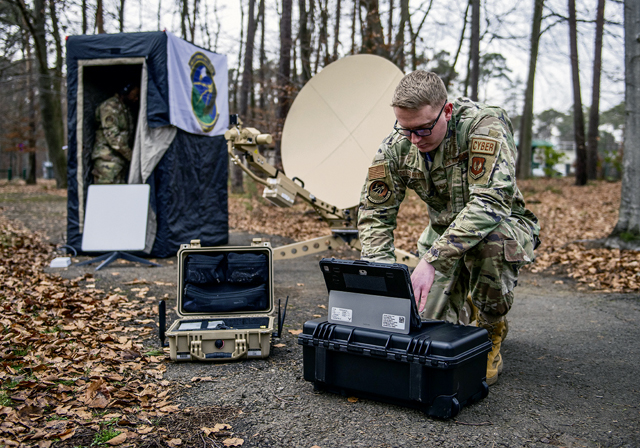
Ramstein Air Base has a long history, with many supporting units ensuring the mission gets done. The 1st Air and Space Communications Operations Squadron is one of those units.
From July 1962 – June 1993 the 2063rd Communications Squadron, out of Lindsey Air Station in Wiesbaden, provided secure communications support to commanders spanning across NATO.
The squadron was later reactivated in May 2003, reassigned to Ramstein AB and given the name it still honors today.
As the only ACOS in the Air Force, the 1st has supported the 435th Air Ground Operations Wing since their redesignation in 2009 by enabling integrated theater air operations, while also ensuring the ACOS mission is executed effectively.
“Our mission is simple – deliver and defend enterprise and tactical C5ISR capabilities to enable the kill chain, anytime, anywhere,” said U.S. Air Force Lt. Col. Phillip Alvarez, 1st ACOS commander. “This is the importance of the squadron; it brings intelligence to the fight.”
Command, control, communications, computers, coalition, intelligence, surveillance and reconnaissance technology enables the warfighter to gain information dominance and decisive lethality, Alvarez explained.
“It’s the ‘nervous system’ of the military, a collection of systems when used collectively to enable the “muscle” side of the military; weapon systems, platforms and troops,” Alvarez said.
The ACOS is divided into five sections to comprehensively accomplish their mission: global command and control systems, infrastructure, joint worldwide intelligence communications systems, security, and the theater network operations center.
These sections synchronize to complete C5ISR capabilities within the U.S. Air Forces in Europe – Air Forces Africa, U.S. Air Force Global Strike Command, and U.S. Air Forces Central Command areas of responsibility.
“The effectiveness of airpower depends on Airmen ensuring assets are employed efficiently and effectively to achieve commander’s intent,” said Chief Master Sgt. Brian Herre, 1st ACOS senior enlisted leader, referencing the Air Force Doctrine Publication 1-1. “Operations in denied, degraded and disrupted environments require flexible and adaptive Airmen who maintain unity of effort by exercising the philosophy of mission command, based on trust, shared awareness and shared intent.”
Since July 2022, the 1st ACOS has had the official authority to operate their BlackNet, subsequently accelerating the U.S. Air and Space Force missions, and effectively applying the agile combat employment doctrine efforts supporting USAFE missions.
BlackNet is an all-network transport system capable of operating in all environments, Alvarez explained. After over 10 years in development, it has allowed 1st ACOS personnel to access the network in austere locations by combining methods of communication such as satellite, cell coverage, fiber optic or ethernet.
“We started BlackNet based on a need to quickly provide Airborne Intelligence, Surveillance and Reconnaissance data to our most forward-based warfighters,” Alvarez said. “What we found through the process is BlackNet is a gamechanger and epitomizes the prior Chief of Staff of the Air Force’s call to accelerate change or lose.”
BlackNet and the personnel who manage it, recently demonstrated the effectiveness of the system when faced with a connectivity issue that could have stopped the mission in its tracks.
“Recently, in a location we had BlackNet, we had a Defense Information Systems Agency outage that would have affected operations,” Alvarez said. “However, by using our BlackNet and our ability to rapidly maneuver, we were able to extend services over commercial satellite and cell phone capabilities and allowed the mission to happen.”
The 1st ACOS is currently the only unit that operates the BlackNet system, however, they are working closely with different major commands to build similar capabilities — ultimately strengthening the DOD’s potential.
“Expanding the use of BlackNet for the DoD creates game changing potential to the way warfighters communicate, enabling new levels of connectivity and communication that were previously impossible,” Alvarez said. “By leveraging a combination of technologies such as wireless networks, cloud computing, military satellites, commercial satellites and fiber networks, BlackNet can provide seamless connectivity and reliable, resilient communications even in contested or degraded environments.”
The 150 Airmen and DoD civilians who currently make up the ACOS team continue to show the world their desire to enhance and grow the Air and Space Forces capabilities.
In its 61 years as a squadron, the teams’ dedication has earned them many awards including 11 Air Force Outstanding Unit Awards, an Air Force Outstanding Unit Award with a Combat ‘V’ Device, and a Navy Meritorious Unit Citation for its support during the Apollo Manned Space Flight Program.
“I have the privilege of leading 150 of the world’s finest Airmen, civilians and contractors, and I am really focused on making sure that we take care of them and their families,” Alvarez said. “They are the biggest asset to the success of our mission.”
Delivering on its slogan, “The Best Done Better,” the 1st ACOS uses teamwork and innovation to be flexible and achieve the mission to deliver, operate and defend C5ISR capabilities.


